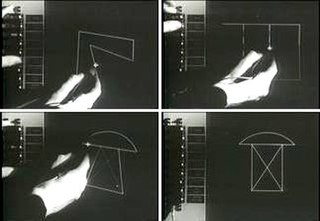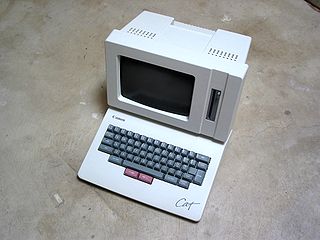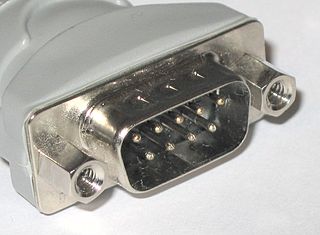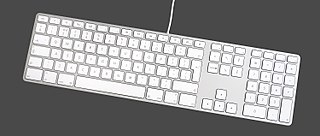
The Apple II series is a family of home computers, one of the first highly successful mass-produced microcomputer products, designed primarily by Steve Wozniak, manufactured by Apple Computer, and launched in 1977 with the original Apple II. In terms of ease of use, features, and expandability, the Apple II was a major advancement over its predecessor, the Apple I, a limited-production bare circuit board computer for electronics hobbyists. Through 1988, a number of models were introduced, with the most popular, the Apple IIe, remaining changed relatively little into the 1990s. A 16-bit model with much more advanced graphics and sound, the Apple IIGS, was added in 1986. While compatible with earlier Apple II systems, the IIGS was in closer competition with the Atari ST and Amiga.

The history of the graphical user interface, understood as the use of graphic icons and a pointing device to control a computer, covers a five-decade span of incremental refinements, built on some constant core principles. Several vendors have created their own windowing systems based on independent code, but with basic elements in common that define the WIMP "window, icon, menu and pointing device" paradigm.

The IBM Personal Computer, commonly known as the IBM PC, is the original version and progenitor of the IBM PC compatible hardware platform. It is IBM model number 5150, and was introduced on August 12, 1981. It was created by a team of engineers and designers under the direction of Don Estridge of the IBM Entry Systems Division in Boca Raton, Florida.
The keyboard for IBM PC-compatible computers is standardized. However, during the more than 30 years of PC architecture being frequently updated, many keyboard layout variations have been developed.

The Apple IIe is the third model in the Apple II series of personal computers produced by Apple Computer. The e in the name stands for enhanced, referring to the fact that several popular features were now built-in that were formerly only available as upgrades or add-ons in earlier models. Improved expandability combined with the new features made for a very attractive general-purpose machine to first-time computer shoppers. As the last surviving model of the Apple II computer line before discontinuation, and having been manufactured and sold for nearly 11 years with relatively few changes, the IIe earned the distinction of being the longest-lived computer in Apple's history.

In computing, a Control key is a modifier key which, when pressed in conjunction with another key, performs a special operation ; similar to the Shift key, the Control key rarely performs any function when pressed by itself. The Control key is located on or near the bottom left side of most keyboards, with many featuring an additional one at the bottom right.

The Apple IIGS, the fifth and most powerful of the Apple II family, is a 16-bit personal computer produced by Apple Computer, Inc. While featuring the Macintosh look and feel, and resolution and color similar to the Commodore Amiga and Atari ST, it remains compatible with earlier Apple II models. The "GS" in the name stands for "Graphics and Sound," referring to its enhanced multimedia hardware, especially its state of the art audio.

The IBM PCjr is a home computer that was produced and marketed by IBM from March 1984 to May 1985. The PCjr was positioned as a complement to the very successful IBM Personal Computer (PC), competing with other home computers such as the Apple II series and the Commodore 64. It retains the IBM PC's 8088 CPU and BIOS interface, but provides enhanced graphics and sound capabilities over the original IBM PC, ROM cartridge slots, joystick ports, and an infrared wireless keyboard. The PCjr supports expansion via "sidecar" modules, which are attached to the side of the unit. New software such as King's Quest I showcased its PC gaming capabilities.

The Canon Cat was a task-dedicated, desktop computer released by Canon Inc. in 1987 at a price of US$1,495. On the surface it was not unlike the dedicated word processors popular in the late 1970s to early 1980s, but it is far more powerful and incorporates many unique ideas for data manipulation.

The D-subminiature or D-sub is a common type of electrical connector. They are named for their characteristic D-shaped metal shield. When they were introduced, D-subs were among the smallest connectors used on computer systems.
The Command key (⌘), also historically known as the Apple key, clover key, open-Apple key, splat key, pretzel key, or propeller key, is a modifier key present on Apple keyboards. The Command key's purpose is to allow the user to enter keyboard commands in applications and in the system. An "extended" Macintosh keyboard—the most common type—has two command keys, one on each side of the space bar; some compact keyboards have one only on the left.
Timeworks Publisher was a desktop publishing (DTP) program produced by GST Software in the United Kingdom.

Arrow keys or cursor movement keys are buttons on a computer keyboard that are either programmed or designated to move the cursor in a specified direction. The term "cursor movement key" is distinct from "arrow key" in that the former term may refer to any of various keys on a computer keyboard designated for cursor movement, whereas "arrow keys" generally refers to one of four specific keys, typically marked with arrows.

The HP 2640A and other HP 264X models were block-mode "smart" and intelligent ASCII standard serial terminals produced by Hewlett-Packard using the Intel 8008 and 8080 microprocessors.

The Option key is a modifier key (ALT) present on Apple keyboards. It is located between the Control key and Command key on a typical Mac keyboard. There are two option keys on modern Mac desktop and notebook keyboards, one on each side of the space bar.

The Apple Keyboard is a keyboard designed by Apple Inc. first for the Apple line, then the Macintosh line of computers. Dozens of models have been released over time, including the Apple Extended Keyboard. Currently, Apple offers only three keyboards via Bluetooth: Magic Keyboard, and Magic Keyboard with Numeric Keypad. The space gray model is also included with the iMac Pro.

Following the introduction of the IBM Personal Computer, or IBM PC, many other personal computer architectures became extinct within just a few years.

Home computers were a class of microcomputers that entered the market in 1977, that started with what Byte Magazine called the "trinity of 1977", and which became common during the 1980s. They were marketed to consumers as affordable and accessible computers that, for the first time, were intended for the use of a single nontechnical user. These computers were a distinct market segment that typically cost much less than business, scientific or engineering-oriented computers of the time such as the IBM PC, and were generally less powerful in terms of memory and expandability. However, a home computer often had better graphics and sound than contemporary business computers. Their most common uses were playing video games, but they were also regularly used for word processing, doing homework, and programming.

The delete key is a key on most computer keyboards which typically is used to delete either the character ahead of or beneath the cursor, or the currently-selected object. The key is sometimes referred to as the "forward delete" key. This is because the backspace key also deletes characters, but to the left of the cursor. On many keyboards, such as most Apple keyboards, the key with the backspace function is also labelled "delete".


















